Mouthpiece and Lay
Purpose of the mouthpiece
Looking at different wind instruments like the flute, the recorder, the clarinet, the oboe and the trumpet, you can see there are quite different mouthpieces:

They all have the same purpose - to create a tone, that is: make the air column within the instrument's body swing. Each example in the picture above does it quite differently, which - to some extend - explains the differences in sound.
A clarinet mouthpiece is nothing more but the end of a cylindrical tube with a flattened end, onto which a reed is fastened, either with a ligature or a cord as can be seen on the picture left (the cord is typical for Germans). One can blow into this end and you will get a somewhat squeaking, high pitched note - but this definitely is a clarinet sound. Ancient woodwind instruments did not have the mouthpiece separated from the instrument, and with very ancient ones the reed was a part of the instruments body (which was made from reed grass), separated by simply sawing a slot between body and reed.
The most individual part of the instrument
If the mouthpiece creates the tone, then all the delicately crafted rest of the clarinet is needed "only" to produce notes of different hight. And it is the mouthpiece that matters most for the sound. However, this is true for most - if not all - wind instruments.
Playing with the same excellent mouthpiece on two different clarinets, one that is simple, made of plastic, and one that is extremely expensive, you will most often find the difference in the sound is in general less significant than using the same instrument with two significantly different mouthpieces. Many players will doubt this - especially when you have paid a lot for your instrument.
But then many players use the same mouthpiece they got with the clarinet from the very beginning and never tried a different one, even when they change their instrument (as long as the mouthpiece still fits). Of course they get used to the properties of the mouthpiece and know from their experience how to handle it. If you change your mouthpiece you will always face problems in the beginning. In fact you can considerably improve both, your tone and even your playing by using a mouthpiece that fits you.
What features can make a difference?
This is mostly about...
- diameter of the bore
- length of the lay or facing
- steepness of the lay or tip opening
- form and volume of the transgression between lay and bore (the chamber)
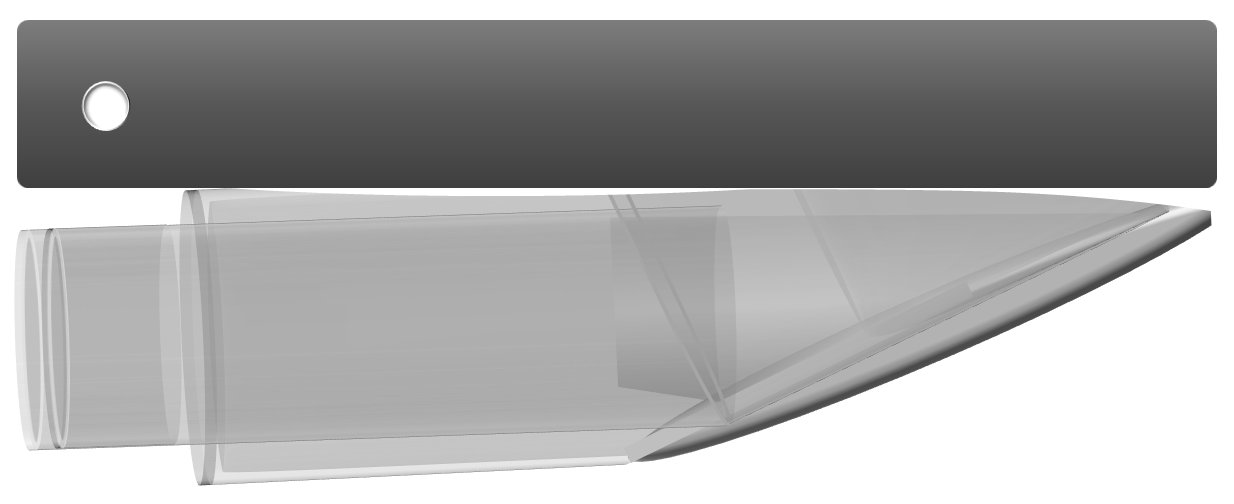
The diameter of the bore is defined by the instrument (or better: its type), because the mouthpiece must have the same bore as the rest of the instrument. This is for example 15,2 mm (equals 0.598 inch) for a German style A- or B flat clarinet and it is 14,9 mm (equals 0.587 inch) for an A or B flat Boehm instrument, just below the mouthpiece.
The lay is the cut-off surface onto which you fix the reed, that has the wind-cut and the tip opening. On first glance the lay seems to be flat. In fact it is not; the surface at which the reed is held with the ligature or a cord (which is called the table) is slightly concave and the tip opening is convex. The idea here is as follows:
- the hollow table bends the reed like a spring when you fix it tightly onto the table. As a result the reed's tip would be a little above a lay, so a thin gap is created that air can flow through.
- the tip opening is convex, that is even with a perfectly flat reed the gap exists, plus a swinging reed will close the wind-cut only for a very very short fraction of time. If the tip opening was flat, the swinging reed would slap upon the sides of the mouthpiece next to the wind-cut creating a croaking or squeaking sound. Because of the bent form even the strongest fff will not cause the reed to slap onto the lay when swinging.
- You will hear that form and volume of the transition in between the mouthpiece and the bore of the instrument is very important. In combination with the oral cavity they form an important part of the "resonance room" of the instrument. That explains why the very same instrument produces a different tone frequency with different players. The oral cavity is part of the swinging air system, it ads to the length of the instrument. Unfortunately, there is far too few practical knowledge about this, so mouthpiece and instrument manufacturers have to work with values drawn from experience.
Different lengths and especially the different bends at the tip opening result in mouth pieces of different "hardness" or "heaviness", that react differently and can respond differently to dynamics.
The choice here depends on individual player's features, especially the setting of the player's jaws and teeth.
Faults and scratches on the mouthpiece result in serious problems
It is critical that the lay on both sides is applied perfectly symmetrical by the instrument or mouthpiece maker. If this goes wrong the reed will not swing the same on both sides and this will result in an uncontrollable swinging behaviour which then results in an uncontrollable instrument - lots of squeaks at best.
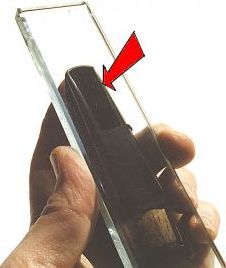
A symmetrical lay can be checked by the "glass test": All you need is a flat piece of glass. You breath on it (to make it foggy), then you roll it over the lay of the mouthpiece. You can recognize the bearing surfaces well. Faults show clearly now. Scratches on the sides of the lay must be avoided absolutely. Therefore the mouthpiece should be wrapped in a cloth before stowing it away in your case or you attach an old reed onto it.
One can have the lay redone by a specialised mouthpiece maker, but then of course all parameters will change, a foreseeable result can't be guaranteed.
How to fix the Reed on the Mouthpiece
There are two ways to fix the reed on the mouthpiece: The classical way is using a cord, binding the reed to the mouthpiece. The majority of the Germans still do it this way, everybody else uses a ligature.
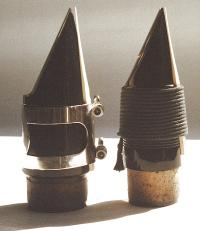
The ligature is nothing new, Iwan Müller has invented it more than 200 years ago. The German mouthpiece has got a special ring for fixing the cord, which makes it impossible to use a standard ligature. On the other hand, on a Boehm instrument, you can always use a cord. Since the cord has advantages (acoustically superior, safer and cheaper than a ligature), I give you a short "how to" below. The only disadvantage of the cord is that binding is a bit slower than using the ligature.
The Ligature
There are ligatures in many variations. There are classical metal ligatures, leather bands and rubber ligatures, spirals and other constructions:
-

- New Ligatures: Variations
All variants of the ligature try to tackle the central problem of the classical ligature, which presses the reed to the mouthpiece at two points only. This is causing the reed to touch the lay at two points in the worst case. That isn't optimal - the reed should be pressed onto the lay's surface for most of the lay's length to be under tension. The cord does this perfectly: Each winding of the cord presses the reed to the lay's surface; there is no sharp point hurting the wood. The development of modern ligatures tries to copy this feature; being it a leather or rubber belt, or a steel net. At the same time the modern ligatures try to keep the advantage of the ligature; being faster than binding.
Fixing the reed with a cord
As I said above, the cord has many advantages over the ligature. Its only disadvantage is that it is somewhat slower to use and you have to practice a bit. Nevertheless every serious player should be able to bind a reed to the mouthpiece, and if it was only as a last resort in case your ligature breaks.
The technique is the same for all sizes of instruments (Eb to counter bass). The difference in procedure is whether you assemble the instrument before or not. You will usually assemble a Bb or Eb clarinet fully, but with a Bass Clarinet you will only put the mouthpiece into the S-bow.
The pictures show how it is done with a Bass Clarinet's mouthpiece, because the size is better suited for fotos:
- Assemble the instrument or at least the mouthpiece and the S-bow.
- Hold the instrument in you left hand, so that the hand is around the barrel and the lower part of the mouthpiece. The thumb is on the lay of the mouthpiece. The indicator is somewhere the same hight as the end of the lay (where the cut-out part of the mouthpiece ends). The left hand stays like this for the whole procedure.
-
Put the reed onto the mouthpiece and hold it with the left thumb in position. The left hand must hold the instrument and the cord is held by the indicator which goes around the mouthpiece. The thumb is holding the reed a small distance below the cut of the reed on the natural part of the reed, where we will wind the cord around in a minute:
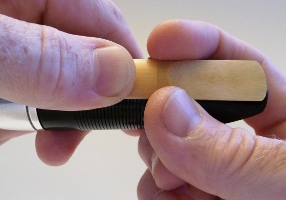
- Position the reed
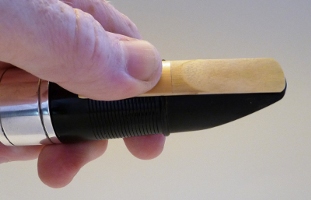
- .. holding the reed with your thumb
-
You continue to hold the instrument with your left hand. Now you put the cord below the mouthpiece
(the reed is on top of the mouthpiece). In order to do so, you hold the instrument only with your
fifth finger while putting the cord over the ring finger, middle finger and indicator.
The short end of the string hangs down from your ring finger, the long end down from your indicator.
The thumb continues fix the reed.
Now you pull the cord until you feel the knot at the cord's end with your ring finger.
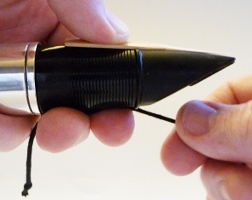
- Put the cord under the mouthpiece
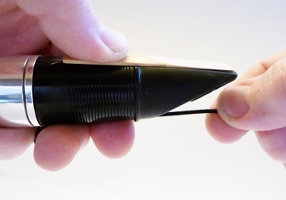
- ... and pull it until you feel the knot.
-
Now - with your right hand - you grab the end of the cord and wind it around the mouthpiece with
the reed for the first time. This first winding should already fix the reed; and when your
continue, the cord will form a spiral around the reed and the end of the cord itself, fixing both.
This spiral will lead away from the tip of the mouthpiece towards the instrument.
-
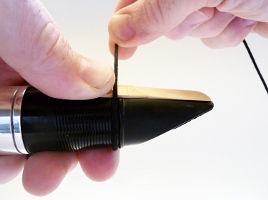
- First winding
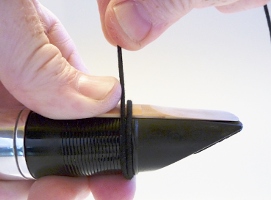
- Fixing the reed
-
-
You bind it with about as much force as you use for your shoe laces.
At the same time make sure you keep the reed at the correct position with your thumb.
You can correct the reed's position later a bit, but you want to get it right at the start nevertheless.
While binding you have to pull back your thumb from the instrument's tip a millimeter with each circle.
-
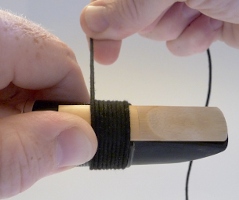
- binding tightly...
-
-
When the cord is nearly completely bound, the reed will be fixed already and it can't be
moved easily any more on the lay. You will have about 8 - 10 cm (2.5 - 3 inches) of cord
which we will use to fix the cord with itself. Therefore we need an "eye"; you get it
by making one round which is quite loose, and the easiest way is to push your thumb forward
under the last winding. Pulling out your thumb and pulling the cord through is all you need,
you can now pull the cord tight.
-
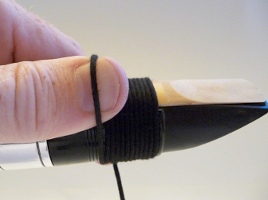
- last round - the "eye"
-
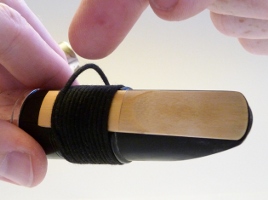
- the eye
-
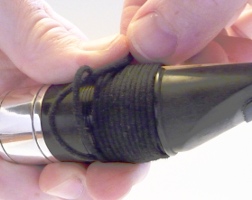
- put the end through
-
- When you want to loosen the reed in the end, you loosen this end of the cord again. You pull the string out of the eye and can now easily loosen the whole cord by pulling the cord. Don't forget to hold the reed on the mouthpiece or else it may fall down and get hurt!
How to find the optimal mouthpiece for yourself
If you are a beginner, you should try some mouthpieces (the one you got with the instrument and one or two others) and then stay with the one you get along best for some time before experimenting. Only change early if you are unhappy and a different mouthpiece makes much of a difference. Rather try different (softer, harder) reeds first. It is difficult for a beginner to find out the best mouthpiece because you haven't developed your personal embouchure and you are busy with technical problems at the same time.
Later (after some time like a year or so playing) you can try out other mouthpieces. Experience in this field helps, now you may try out every mouthpiece that you can get your hands on unless they tell you your playing is perfect (wiping a mouthpiece with some disinfecting cloth might be a good idea before using it and before giving it back, because viruses and bacteria stay infective for more than some moments - sometimes for months!).
If possible you should take some hours time to play on a mouthpiece in order to find out whether you really get along with it well - especially if it has a different lay than your own. Different lays may require different reeds so you might want to get some of those. European instrument dealers will usually be ready to offer you a variety of mouthpieces to try out for some time - like a weekend. This is important because even the most perfect mouthpiece for you will make difficulties if you are used to something different.
Have others listening to your playing. But then select and stay with the one and play this one a lot. From time to time, however, one should go and try out an alternative one.
Can germs be transmitted playing on somebody elses mouthpiece?
Of course they can. It's like drinking from one bottle together: Many viruses and most bacteria remain infectuous on a moist mouthpiece or reed for hours, some bacteria may stay dangerous in a dry state for many days, months, some can "wake up" when put into water after having "slept" in a spore form for years.
Wiping with the hand or a handkerchief is not enough. The best way is to spray and wipe thoroughly with disinfectant (alcohol spray), it should say "bactericide and virus deactivating". Of course, you should take care to use a spray that does not damage the mouthpiece. If you don't like the taste or smell of it, just rinse the mouthpiece and the reed under water after that.
Especially clarinet teachers should use disinfectants for their own protection and to prevent spreading germs from one player to the next.